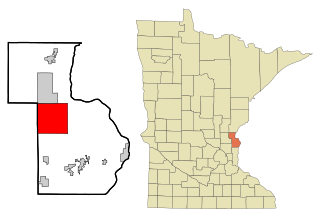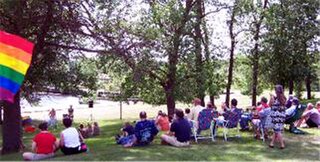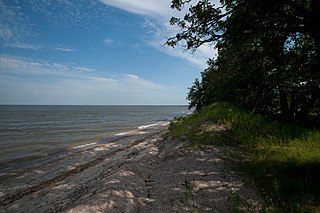
Pine County is a county located in the U.S. state of Minnesota. As of the 2010 census, the population was 29,750. Its county seat is Pine City. The county was formed in 1856 and organized in 1872.
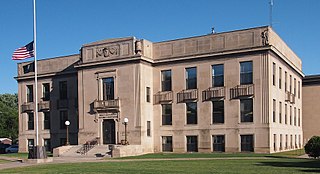
Mille Lacs County is a county in the U.S. state of Minnesota. As of the 2010 census, the population was 26,097. Its county seat is Milaca. The county was founded in 1857, and its boundary was expanded in 1860.
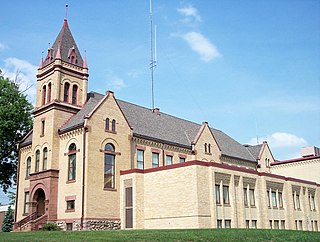
Kanabec County is a county in the U.S. state of Minnesota. As of the 2010 census, the population was 16,239. Its county seat is Mora. The county was founded on March 13, 1858, from Pine County and organized in 1882. It is named after the Ojibwe ginebig, meaning "snake," after the Snake River — Kanabecosippi — which flows through the county.

Chisago County is a county located in the U.S. state of Minnesota. As of the 2010 census, the population was 53,887. Its county seat is Center City. The county's name comes from Chisago Lake.
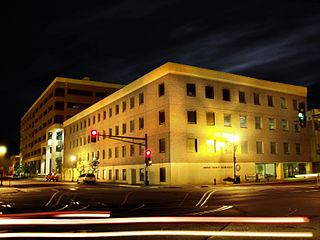
Anoka County is the fourth-most-populous county in the U.S. state of Minnesota. As of the 2010 census, the population was 339,534. The county seat and namesake of the county is the City of Anoka, which is derived from the Dakota word anokatanhan meaning "on both sides," referring to its location on the banks of the Rum River. The largest city in the county is the City of Blaine, the thirteenth-largest city in Minnesota and the eighth-largest Twin Cities suburb.
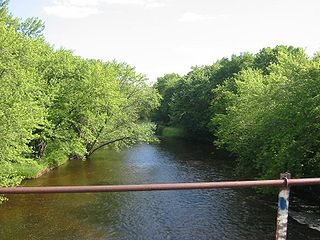
The Rum River is a slow, meandering channel that connects Minnesota's Mille Lacs Lake with the Mississippi River. It runs for 151 miles (243 km) through the communities of Onamia, Milaca, Princeton, Cambridge, Isanti, and St. Francis before ending at the Twin Cities suburb of Anoka, roughly 20 miles northwest of downtown Minneapolis. It is one of the six protected Wild and Scenic rivers in Minnesota.
Mille Lacs Indian Reservation is the popular name for the land-base for the Mille Lacs Band of Ojibwe in Central Minnesota, about 100 miles (160 km) north of Minneapolis-St. Paul. The contemporary Mille Lacs Band reservation has significant land holdings in Mille Lacs, Pine, Aitkin and Crow Wing counties, as well as other land holdings in Kanabec, Morrison, and Otter Tail Counties. Mille Lacs Indian Reservation is also the name of a formal Indian reservation established in 1855. It is one of the two formal reservations on which the contemporary Mille Lacs Band retains land holdings. The contemporary Mille Lacs band includes several aboriginal Ojibwe bands and villages, whose members reside in communities throughout central Minnesota.
Minnesota State Highway 47 is a highway in east–central Minnesota, which runs from its intersection with Central Avenue in Minneapolis and continues north to its northern terminus at its intersection with U.S. Highway 169 in Aitkin.

The Sunrise River is a 39.1-mile-long (62.9 km) tributary of the St. Croix River in East Central Minnesota in the United States. It is formed at the city of Forest Lake in Washington County at the outlet of Forest Lake. The river flows north, accepting the South Branch from the west near the city of Wyoming, and continues north into Mud Lake, where the West Branch, which rises in southeast Isanti County and briefly enters Anoka County, joins it near the city of Stacy. From Stacy it flows generally north-northwest through Chisago County to meet the St. Croix River within Wild River State Park near the communities of Sunrise and Almelund. Not far upstream from its mouth, the Sunrise collects its North Branch, which rises in Isanti County and flows through the city of North Branch.

The Snake River is a 104-mile-long (167 km) tributary of the St. Croix River in East Central Minnesota in the United States. It is one of three streams in Minnesota with this name. Its name is a translation from the Ojibwa Ginebigo-ziibi, after the Dakota peoples who made their homes along this river. Kanabec County is named after this river.
The Knife River is a 27.4-mile-long (44.1 km) tributary of the Snake River in East Central Minnesota in the United States. It is one of three streams in Minnesota with this name. Its name is a translation from the Dakota Isaanti. Knife Lake and Santee Sioux are named after this river. In turn Isanti County is named after the Santee Sioux.

The District Court of Minnesota is the state trial court of general jurisdiction in the U.S. state of Minnesota.
County roads in Minnesota are roads locally maintained by county highway departments in Minnesota. County roads span a wide variety of road types, varying from A-minor arterials that carry large volumes of traffic to an improved road.

The 1996 United States presidential election in Minnesota took place on November 5, 1996, as part of the 1996 United States presidential election. Voters chose ten representatives, or electors to the Electoral College, who voted for president and vice president.

Greeley is an unincorporated community in Royalton Township, Pine County, Minnesota, United States.

The Minnesota Department of Natural Resources Division of Enforcement is the law enforcement division of the Minnesota Department of Natural Resources, the State of Minnesota's Natural Resource Management State agency. The main focus of the Division of Enforcement is public safety and enforcement of the state's laws and regulations pertaining to wildlife, fishing, outdoor recreation, hunting, All-terrain vehicles, and boating throughout the state. In addition, officers patrol Department of Natural Resources lands and public waters, including Minnesota State Parks, Minnesota State Forests, Wildlife Management Areas, and Scientific & Natural Areas. Law enforcement officers in this division are called Minnesota State Conservation Officers, and are fully licensed state peace officers that have jurisdiction throughout the State of Minnesota to enforce state laws.

The Rum River State Forest is a state forest located in Kanabec, Mille Lacs and Morrison counties in central Minnesota. The forest is nearby the city of Onamia and is along the Rum River, just downstream (south) of Mille Lacs Lake. The forest is managed by the Minnesota Department of Natural Resources. The forest is home to many Northern hardwoods such as maple, oak, ash, elm and basswood that occupy most of the upland areas while tamarack and black spruce are found in lowland and marshy areas.




